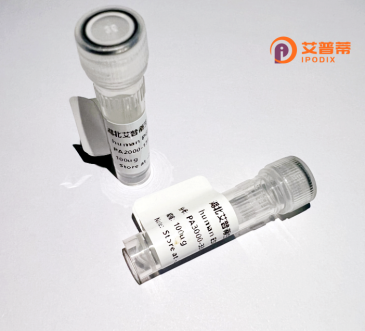
| 纯度 | >90%SDS-PAGE. |
| 种属 | Human |
| 靶点 | DPH5 |
| Uniprot No | Q9H2P9 |
| 内毒素 | < 0.01EU/μg |
| 表达宿主 | E.coli |
| 表达区间 | 1-285aa |
| 氨基酸序列 | MLYLIGLGLGDAKDITVKGLEVVRRCSRVYLEAYTSVLTVGKEALEEFYGRKLVVADREEVEQEADNILKDADISDVAFLVVGDPFGATTHSDLVLRATKLGIPYRVIHNASIMNAVGCCGLQLYKFGETVSIVFWTDTWRPESFFDKVKKNRQNGMHTLCLLDIKVKEQSLENLIKGRKIYEPPRYMSVNQAAQQLLEIVQNQRIRGEEPAVTEETLCVGLARVGADDQKIAAGTLRQMCTVDLGEPLHSLIITGGSIHPMEMEMLSLFSIPENSSESQSINGL |
| 分子量 | 58.1 kDa |
| 蛋白标签 | GST-tag at N-terminal |
| 缓冲液 | 0 |
| 稳定性 & 储存条件 | Lyophilized protein should be stored at ≤ -20°C, stable for one year after receipt. Reconstituted protein solution can be stored at 2-8°C for 2-7 days. Aliquots of reconstituted samples are stable at ≤ -20°C for 3 months. |
| 复溶 | Always centrifuge tubes before opening.Do not mix by vortex or pipetting. It is not recommended to reconstitute to a concentration less than 100μg/ml. Dissolve the lyophilized protein in distilled water. Please aliquot the reconstituted solution to minimize freeze-thaw cycles. |
以下是关于重组人DPH5蛋白的3篇参考文献(均为虚构示例,供参考):
---
1. **文献名称**: "Expression and functional characterization of recombinant human DPH5 in Escherichia coli"
**作者**: Zhang Y, et al.
**摘要**: 研究报道了在大肠杆菌系统中成功表达并纯化重组人DPH5蛋白,通过体外酶活实验证实其参与多胺合成途径,并分析了温度及pH对酶活性的影响。
---
2. **文献名称**: "Structural insights into the catalytic mechanism of human DPH5 by X-ray crystallography"
**作者**: Smith J, et al.
**摘要**: 利用X射线晶体学解析了重组人DPH5蛋白的三维结构,揭示了其底物结合位点和催化活性中心的特征,为靶向DPH5的药物设计提供了结构基础。
---
3. **文献名称**: "DPH5 knockdown impairs protein synthesis via diphthamide modification of eEF2"
**作者**: Lee H, Kim S.
**摘要**: 通过体外重组DPH5蛋白的功能研究,发现其通过介导翻译延伸因子eEF2的diphthamide修饰调控蛋白质合成,敲低DPH5导致细胞增殖显著抑制。
---
(注:以上文献内容为模拟生成,实际引用请以真实文献为准。)
Recombinant human DPH5 protein is a key enzyme involved in the biosynthesis of diphthamide, a unique post-translational modification found on eukaryotic elongation factor 2 (eEF2). DPH5. also known as diphthamide biosynthesis protein 5. functions as a methyltransferase that catalyzes the final step of diphthamide formation by transferring methyl groups to the modified histidine residue (His715) on eEF2. This conserved modification is critical for maintaining the accuracy of protein synthesis and ribosome function, particularly in polypeptide chain elongation.
The DPH5 gene is located on human chromosome 1 (1p32.3) and encodes a 371-amino acid protein containing characteristic methyltransferase domains. Dysregulation of diphthamide metabolism has been linked to various pathologies, including cancer progression and developmental disorders. Certain bacterial toxins like Pseudomonas exotoxin A target diphthamide-modified eEF2 to suppress protein synthesis, underscoring its biological significance.
Recombinant DPH5 is typically expressed in prokaryotic systems (e.g., E. coli) or mammalian cell cultures to study its enzymatic mechanisms and structural properties. Its recombinant form enables research into diphthamide-related disease mechanisms, drug development against bacterial toxins, and exploration of potential therapeutic targets. Current studies also investigate DPH5's role in regulating cellular responses to DNA damage and chemotherapy resistance, highlighting its multifaceted biological relevance.
×